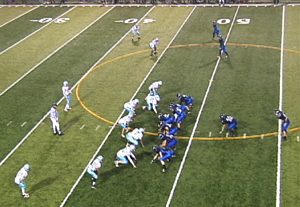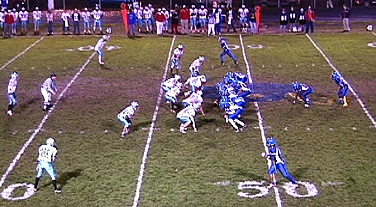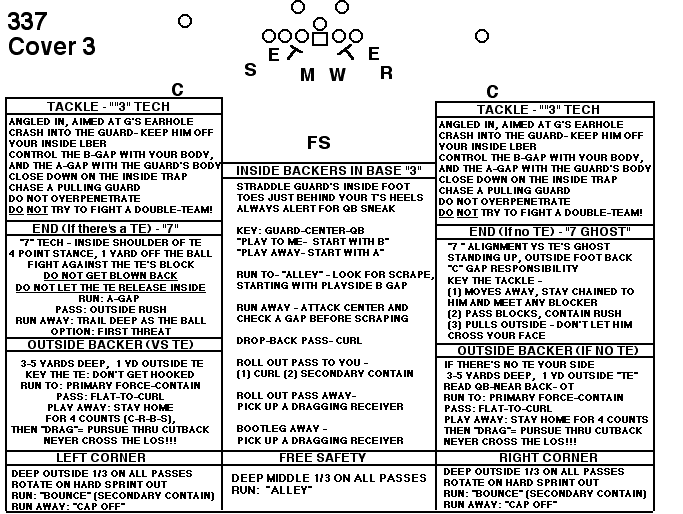

BASICS OF THE TWIN TILT DEFENSE
  |
|
|
"3" (alignment of the strong tackle & backer) "3" (alignment of the weak tackle & backer) "7" (end's alignment against a Tight End)

I like to play an even front, jumping back and forth between what I call a 1-1 and a 3-3 (and hybrids - combinations of the two) as I have been doing since 1982. It allows me to be flexible. It is an unusual look for opponents. It is relatively easy to teach and it allows kids to be aggressive.
And on occasions that dictate an odd front, it is easy to put one of the inside linebackers done on the nose, and play a 5-3.
The first number of the defensive call refers to the technique our tackle plays on the TE side, the second number to the tackle's technique on the split side. So if we call a 3-3, both tackles play a "3" technique.Normally, If opponents play with a TE, we'll use a 3-3. If opponents spread out, we may play a 1-1 or a hybrid (3-1 or 1-3) front in order to get our inside LBers out a little wider.
I got the Twin Tilt 3-3 from the Western Kentucky staff in 1980, and I got the 1-1 (wide tackle 6) from Maryland, where Jerry Claiborne ran it in the 1970's. Since Coach Claiborne got it from Coach Bryant while they were both at Kentucky, I guess you could say much of my defense originated in the Bluegrass State (although I suspect that Coach Bryant ran his wide-tackle 6 because that's what General Neyland ran at Tennessee, and nobody played defense like Tennessee. (Even the Bear could only beat Tennessee once in eight tries.)
By combining the fronts to form a hybrid (either a 1-3 or 3-1) we wind up in Vince Dooley's "Split 60" front, which he popularized at Georgia as his "Junkyard Dog" defense.
Depending on the stuff we see and the kind of kids we have, we might play cover 3 (three-deep zone) most of the way, but when we have the talent to man-up against people we may sometimes do that, and I really do like to play a cover 2 (two-deep zone).
(Briefly, we get into cover 2 by rolling our secondary to a two-receiver side, then kicking our weakside LBer (Rover) out onto the nearest wide receiver on the split end side.)
The 3-3 is a very aggressive defense that creates difficult blocking problems for offenses as well as automatic blitzes.
In the tackles' "3" technique they are angled in at 45 degrees, crowding the outside shoulder of the guards ("looking into his ear hole.") They attack the guard, caving him into the "A" gap while occupying the "B" gap with their body. They must shut down the inside trap and keep the guard off our inside LBers, chasing him if he pulls. The basic no-nos are (1) don't let the guard off easy; (2) don't get trapped; (3) don't get hooked by the guard; (4) don't get cut off by the tackle on plays away; (5) don't get driven back by a double-team ("grab grass").
Inside LBers' "3" technique has them lined up head-up on the guards, toes about 6 inches deeper than the defensive tackles' heels (because if play comes their way, they must scrape off their tackle's heels and check the playside "B" gap - if play goes away, they attack the center's head and fight through it.) They must always be alert for the QB sneak because that is the first thing people will do when they see this look.
On a run their way, they whip the tackle and force their way into the backfield. On a run away from them. they whip the center and get into pursuit.
Against a drop-back pass, they play TE dump-to-hook-to-curl (or SE slant-to-curl) on their side; against sprint-out their way, they play hook-to-curl-to-secondary contain; against sprint away, they play playside hook-to-curl.
You may sometimes find through scouting or film study that you are able to read the opponents' center - he may show "pass" right away, or he may always block "away". If so, you must discipline your 3-3 inside LBers to read the center - get their stance as low as possible, so their eyes are as low as the linemen's eyes, removing the temptation to look into the backfield.
On the side of a Tight End, ends may play a "crashing 8" or a "7" technique. (If I have an unusually aggressive kid who enjoys contact on every play, I prefer the crashing "8" because it allows you to turn him loose.) Either way, "7" or "8", the end is responsible for the "C" gap.
The end's "crashing 8" technique has him about 1-1/2 yards outside the Tight End, angled in at 45 degrees in 3- or 4-point stance ("aimed at his butt"). He slants aggressively at the TE's butt, and after first making sure that the TE doesn't hook him, he stay son that course, and unless he sees the ball come immediately off the line, he works "down the buttline" of the offensive linemen, trying to blow up plays at the line of scrimmage, and only deepening his charge when he sees the ball come off the line.
Against an option, he will blow up the first threat along the line, normally either the dive or the QB.
On action away, he stays close to the line to blow up the blocker on a counter, and against a drop-back pass, he deepens, always keeping outside leverage. On a rollout to his side, we expect him to do this best to contain, but we know that the QB may break contain, and in that event, we expect the inside LBer to take secondary contain.
The "7" technique puts our defensive end in a four-point stance on the inside eye of the TE. He slams the TE and does not let him release inside. He has "C" gap responsibility, and if the TE releases outside he stays square and holds his ground and looks inside for first threat: dive, blocker, option QB, ball off the line (pass).
Outside LBers in normal Cover 3 have contain on run and flat on pass. If the ball goes away from them, they "spy" - they stay home, because they are responsible for counters, reverses, throwbacks, screens. They must never chase the play that goes away from them. When they have mentally checked off- we make them say "counter, reverse, bootleg, screen" - they pursue deep to the far corner, alert for a cutback.
When the end plays an "8" technique the outside LBer vs a TE lines up opposite the TE, depth varying from in the TE's face to 5 yards deep in obvious pass situations. He will always put something on the TE if he releases. He does not let him off the line easily, but he is responsible ultimately for containing anything that gets outside his DE, so he can't let himself get hooked by that TE. He keys the TE, who will either (1) Try to come down on the inside LBer (2) Fire out on him (3) Turn out on the "8" technique end (4) pass block or (5) Release for a pass
If there is no TE on his side, an end plays a "standup 7" against the "TE's Ghost," and reads the tackle first.. He looks like a LBer. He is in a semi-crouch with his shoulders square to the line and his inside foot forward. He plays "on" the "TE's Ghost," about a yard outside the offensive tackle. He does not cross the line of scrimmage unless it is a drop-back pass. His primary responsibility is the C-gap between him and the offensive tackle. He reads the tackle. If the tackle blocks down, our end closes down the C-gap, staying square and holding hi ground and meeting any blocker. He will never let the tackle hook him or cross his face on a pull to the outside. If a quick pass shows, he immediately makes a picket fence - he throws his arms in the air right away, before doing anything else. If it is a drop-back pass, he rushes from the outside and keeps outside leverage. He never ducks inside any blocker. If the tackle pulls away, he will normally chase "down the butt line.".
The outside LBer on the side away from the TE has contain on a run or flat on a pass. He can line up in the shadow of the DE, or walked away from the DE, or he can move out and bump a SE and hold him up (in which case we may also roll our secondary into a Cover 2) , but regardless, his responsibility doesn't change - contain or flat on plays to his side, stay home and spy on plays away before "running a drag" - pursuing on the lookout for the cutback.
Against a 3-step, quick passing team, it is important for your ends to throw their hands up in the air whenever the offensive tackle pass blocks and the QB sets up quick. (Your ends are not going to sack a 2- or 3-step QB from the outside anyhow, and it is amazing how many quick flat, hitch and slant passes they will bat down this way.)
If a tight end is flexed more than a couple of yards, to the point where he can't legally block down on our DE if we move him back inside, we will bring our end in to a "7 Ghost" technique. If there is a chance that our end can be cracked down on, we may have him turn his back to the defender and face inside. The OLB will play outside eye on the TE same as he would do against a wide-out in a cover 2 technique. He will jam that TE and hold him up, but his main responsibility is still force/contain, flat, pitch (and spy on plays away).
The basic rule for aligning the OLB is: never be outflanked by two eligibles: If there are two eligibles out to the his side, the OLB always lines up on the #2 eligible to his side, jamming him and forcing.
In a definite passing situation, we have our tackles rush the B gaps and the ends take a deeper charge. (One of your tackles or ends should be assigned to watch for draw.)
Our basic stunts, from either a "3" or "1" alignment
"STRONG" - Strongside DT shoots his B gap, weakside DT crosses the face of the guard and attacks the center
(We will occasionally make a "Weak" call, just so people don't get cocky about the predictability of our weak side look.)
"BLOOD" - inside backers blitz the "B" gaps - DT's attack the "A" gaps.
"GUTS" - inside backers blitz the "A" gaps - DT's shoot their B gaps.
"STUD" - (Strongside DE-LB Switch) Strong outside LBer fires through "C" gap, strong end holds and plays contain
"WHIP" - (Weakside DE-LB Switch) outside LBer fires from outside, weak end jab-steps at tackle, loops outside and plays contain
COMBINATIONS:
"BLITZ" - Combination of both STUD and WHIP
"STRONG BLITZ"
"BLOOD BLITZ"
"GUTS BLITZ"